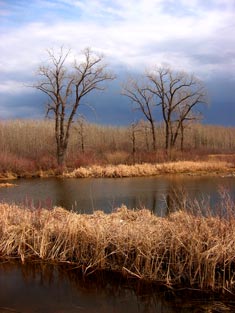Holiday season – View holiday hours for City of Winnipeg facilities and services from December 24 to January 1.
Wetlands
A wetland is a depression of land which contains water for all or most of the year. Prairie wetlands get their water from snow, rain, and groundwater. Wetlands can be large or small, shallow or deep. They can be filled with plants from one end to the other, or they can be open water with plants growing mostly around the edges.
 The different types of wetland that can be found in Winnipeg and the surrounding area include: Swamps - a wetland dominated by trees or shrubs. Marshes - a wetland frequently or continually filled with water, with plants that are adapted to growing in wet or saturated soils. Potholes - shallow marsh-like ponds that may not hold water during periods of dry weather. Fens - a wetland with marshlike vegetation that develops in an area of organic solids (peat) that receives some water draining from surrounding mineral soils. Bogs - a wetland dominated by mosses and conifer trees that develop in an area of organic soils (peat) and no inflows or outflows of water.
The different types of wetland that can be found in Winnipeg and the surrounding area include: Swamps - a wetland dominated by trees or shrubs. Marshes - a wetland frequently or continually filled with water, with plants that are adapted to growing in wet or saturated soils. Potholes - shallow marsh-like ponds that may not hold water during periods of dry weather. Fens - a wetland with marshlike vegetation that develops in an area of organic solids (peat) that receives some water draining from surrounding mineral soils. Bogs - a wetland dominated by mosses and conifer trees that develop in an area of organic soils (peat) and no inflows or outflows of water.
Within a wetland there can be a number of different zones, where habitat conditions vary, depending on the level of the water. A wet meadow is an area with wet soils but no open water. Plants growing here need more moisture than the drier prairie plants but do not like to be flooded for very long each year. The area called the emergent marsh occurs where the water is shallow around the edges of marshes and potholes. Plants living here are able to grow in standing water and are tall enough to emerge above the water to reach the sunlight. If the water level in the wetland drops, the emergent marsh can become an exposed mudflat. If this area stays without water for some time, plants that do not like to be flooded will begin to grow here. An area of permanent open water can be found in some larger marshes and swamps. Plants growing in this deeper water may appear to be floating on the surface but most have stems and leaves that are submerged below the water.
